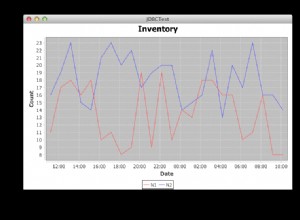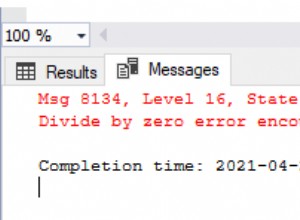Oracle क्लाउड इन्फ्रास्ट्रक्चर और टेराफॉर्म को समर्पित श्रृंखला के तीसरे अध्याय में आपका स्वागत है, यदि आप पिछले अध्यायों से चूक गए हैं तो आप लिंक पा सकते हैं:
- टेराफॉर्म Oracle क्लाउड प्रदाता सेटअप करें।
- टेराफॉर्म का उपयोग करके Oracle क्लाउड कंप्यूट इंस्टेंस को परिनियोजित करें
अपना पहला इंस्टेंस सफलतापूर्वक लॉन्च करने के बाद अब हम एक अधिक जटिल उदाहरण के लिए तैयार हैं।
पर्यावरण सेटअप
हमारे भंडार में, निर्देशिका बदलें और इंस्टेंस-पूल निर्देशिका के अंदर जाएं:
cd oracle-cloud-terraform-examples/instance-pool/
vars.tf को उसी तरह संशोधित करें जैसे कि सरल उदाहरण उदाहरण में vars.tf फ़ाइल को संशोधित किया है (vars.tf फ़ाइल को स्क्रैच से सेटअप करने के लिए वेरिएबल्स सेटअप अनुभाग का पालन करें)
अतिरिक्त चर
इस उदाहरण में हमारे पास कुछ अतिरिक्त चर हैं:
| परिवर्तनीय | डिफ़ॉल्ट | <थ>विवरण|
|---|---|---|
fault_domains | "FAULT-DOMAIN-1", "FAULT-DOMAIN-2", "FAULT-DOMAIN-3" | यह चर दोष डोमेन की एक सूची है जहां हमारा इंस्टेंस पूल हमारे इंस्टेंस को परिनियोजित करेगा |
instance_pool_size | 2 | इंस्टेंस पूल में लॉन्च किए जाने वाले इंस्टेंस की संख्या |
इंफ्रास्ट्रक्चर ओवरव्यू
इन्फ्रास्ट्रक्चर साधारण उदाहरण उदाहरण के समान है लेकिन हमारे पास यह भी है:
- एक नेटवर्क लोड बैलेंसर, जो इंटरनेट से ट्रैफ़िक को हमारे इंस्टेंस पूल इंस्टेंस पर रूट करेगा
- इंस्टेंस पूल द्वारा उपयोग किया जाने वाला एक इंस्टेंस कॉन्फ़िगरेशन
- एक उदाहरण पूल
- इंस्टेंस पूल द्वारा लॉन्च किए गए दो Oracle कंप्यूट इंस्टेंस
नेटवर्क लोड बैलेंसर द्वारा बनाया गया है:
- एक श्रोता (पोर्ट 80)
- एक समर्थित सेट
- इंस्टेंस पूल में प्रत्येक इंस्टेंस के लिए एक समर्थित
नोट्स
कुछ महत्वपूर्ण नोट:
- डिफॉल्ट रूप से कंप्यूट इंस्टेंस पर फ़ायरवॉल अक्षम है। कुछ परीक्षणों में फ़ायरवॉल ने कुछ समस्याएं पैदा की हैं
- Nginx डिफ़ॉल्ट रूप से स्थापित किया जाएगा (nginx का उपयोग सुरक्षा सूची नियमों के परीक्षण के लिए और नेटवर्क लोड बैलेंसर सेटअप के परीक्षण के लिए किया जाता है)
- उपयोग किया गया ऑपरेटिंग सिस्टम उबंटू 20.04 है
परिनियोजित करें
अब terraform.tfvars फाइल (टेराफॉर्म सेटअप सेक्शन) बनाएं और टेराफॉर्म को इनिशियलाइज़ करें:
terraform init
Initializing the backend...
Initializing provider plugins...
- Finding latest version of hashicorp/oci...
- Installing hashicorp/oci v4.50.0...
- Installed hashicorp/oci v4.50.0 (signed by HashiCorp)
Terraform has created a lock file .terraform.lock.hcl to record the provider
selections it made above. Include this file in your version control repository
so that Terraform can guarantee to make the same selections by default when
you run "terraform init" in the future.
Terraform has been successfully initialized!
You may now begin working with Terraform. Try running "terraform plan" to see
any changes that are required for your infrastructure. All Terraform commands
should now work.
If you ever set or change modules or backend configuration for Terraform,
rerun this command to reinitialize your working directory. If you forget, other
commands will detect it and remind you to do so if necessary.
अब हम अपने बुनियादी ढांचे को तैनात करने के लिए तैयार हैं:
terraform plan
Terraform used the selected providers to generate the following execution plan. Resource actions are indicated with the following symbols:
+ create
Terraform will perform the following actions:
# oci_core_default_route_table.default_oci_core_default_route_table will be created
+ resource "oci_core_default_route_table" "default_oci_core_default_route_table" {
+ compartment_id = (known after apply)
+ defined_tags = (known after apply)
+ display_name = (known after apply)
+ freeform_tags = (known after apply)
+ id = (known after apply)
+ manage_default_resource_id = (known after apply)
+ state = (known after apply)
+ time_created = (known after apply)
+ route_rules {
+ cidr_block = (known after apply)
+ description = (known after apply)
+ destination = "0.0.0.0/0"
+ destination_type = "CIDR_BLOCK"
+ network_entity_id = (known after apply)
}
}
<TRUNCATED OUTPUT>
Plan: 14 to add, 0 to change, 0 to destroy.
Changes to Outputs:
+ instances_ips = [
+ (known after apply),
+ (known after apply),
]
+ lb_ip = (known after apply)
──────────────────────────────────────────────────────────────────────────────────────────────────────────────────────────────────────────────────────────────────────────────────────────────────────────────────────
Note: You didn't use the -out option to save this plan, so Terraform can't guarantee to take exactly these actions if you run "terraform apply" now.
अगर हमारे पास कोई त्रुटि नहीं है:
terraform apply
Terraform used the selected providers to generate the following execution plan. Resource actions are indicated with the following symbols:
+ create
<= read (data resources)
Terraform will perform the following actions:
# data.oci_core_instance.ubuntu_instance_pool_instances_ips[0] will be read during apply
# (config refers to values not yet known)
<= data "oci_core_instance" "ubuntu_instance_pool_instances_ips" {
+ agent_config = (known after apply)
+ async = (known after apply)
+ availability_config = (known after apply)
+ availability_domain = (known after apply)
+ boot_volume_id = (known after apply)
+ capacity_reservation_id = (known after apply)
+ compartment_id = (known after apply)
+ create_vnic_details = (known after apply)
+ dedicated_vm_host_id = (known after apply)
+ defined_tags = (known after apply)
+ display_name = (known after apply)
+ extended_metadata = (known after apply)
+ fault_domain = (known after apply)
+ freeform_tags = (known after apply)
+ hostname_label = (known after apply)
+ id = (known after apply)
+ image = (known after apply)
+ instance_id = (known after apply)
+ instance_options = (known after apply)
+ ipxe_script = (known after apply)
+ is_pv_encryption_in_transit_enabled = (known after apply)
+ launch_mode = (known after apply)
+ launch_options = (known after apply)
+ metadata = (known after apply)
+ platform_config = (known after apply)
+ preemptible_instance_config = (known after apply)
+ preserve_boot_volume = (known after apply)
+ private_ip = (known after apply)
+ public_ip = (known after apply)
+ region = (known after apply)
+ shape = (known after apply)
+ shape_config = (known after apply)
+ source_details = (known after apply)
+ state = (known after apply)
+ subnet_id = (known after apply)
+ system_tags = (known after apply)
+ time_created = (known after apply)
+ time_maintenance_reboot_due = (known after apply)
}
<TRUNCATED OUTPUT>
oci_network_load_balancer_listener.test_listener: Creation complete after 25s [id=networkLoadBalancers/ocid1.networkloadbalancer.oc1.eu-zurich-1.amaaaaaa5kjm7pyarkfapfnqqxrwaowlnmj5mnd3etmig5nfcwd3m5yb7uha/listeners/LB%20test%20listener]
oci_network_load_balancer_backend.test_backend[1]: Still creating... [31s elapsed]
oci_network_load_balancer_backend.test_backend[0]: Still creating... [31s elapsed]
oci_network_load_balancer_backend.test_backend[0]: Still creating... [41s elapsed]
oci_network_load_balancer_backend.test_backend[1]: Still creating... [41s elapsed]
oci_network_load_balancer_backend.test_backend[0]: Creation complete after 42s [id=networkLoadBalancers/ocid1.networkloadbalancer.oc1.eu-zurich-1.amaaaaaa5kjm7pyarkfapfnqqxrwaowlnmj5mnd3etmig5nfcwd3m5yb7uha/backendSets/Backend%20set%20test/backends/ocid1.instance.oc1.eu-zurich-1.an5heljr5kjm7pycu5exolhnubsq5isqo6nveddlmlsblkz7geb6vbwsvbtq.80]
oci_network_load_balancer_backend.test_backend[1]: Still creating... [51s elapsed]
oci_network_load_balancer_backend.test_backend[1]: Still creating... [1m1s elapsed]
oci_network_load_balancer_backend.test_backend[1]: Still creating... [1m11s elapsed]
oci_network_load_balancer_backend.test_backend[1]: Creation complete after 1m14s [id=networkLoadBalancers/ocid1.networkloadbalancer.oc1.eu-zurich-1.amaaaaaa5kjm7pyarkfapfnqqxrwaowlnmj5mnd3etmig5nfcwd3m5yb7uha/backendSets/Backend%20set%20test/backends/ocid1.instance.oc1.eu-zurich-1.an5heljr5kjm7pycft5ixge6ssknpyb5s6q3eihuccogpqrvv2ntqdlww72a.80]
Apply complete! Resources: 14 added, 0 changed, 0 destroyed.
Outputs:
instances_ips = [
"132.x.x.x",
"152.x.x.x",
]
lb_ip = tolist([
{
"ip_address" = "140.x.x.x"
"is_public" = true
"reserved_ip" = tolist([])
},
])
अब हम तैनात उदाहरणों में से एक में ssh कर सकते हैं:
ssh [email protected]
...
35 updates can be applied immediately.
25 of these updates are standard security updates.
To see these additional updates run: apt list --upgradable
The programs included with the Ubuntu system are free software;
the exact distribution terms for each program are described in the
individual files in /usr/share/doc/*/copyright.
Ubuntu comes with ABSOLUTELY NO WARRANTY, to the extent permitted by
applicable law.
To run a command as administrator (user "root"), use "sudo <command>".
See "man sudo_root" for details.
ubuntu@inst-ikudx-ubuntu-instance-pool:~$
कुछ मिनटों के बाद (कम से कम एक बैकएंड स्वास्थ्य स्थिति में होना चाहिए) भी नेटवर्क लोड बैलेंसर हमारे अनुरोधों का जवाब देगा:
curl -v 140.x.x.x
* Trying 140.x.x.x:80...
* TCP_NODELAY set
* Connected to 140.x.x.x (140.x.x.x) port 80 (#0)
> GET / HTTP/1.1
> Host: 140.x.x.x
> User-Agent: curl/7.68.0
> Accept: */*
>
* Mark bundle as not supporting multiuse
< HTTP/1.1 200 OK
< Server: nginx/1.18.0 (Ubuntu)
< Date: Wed, 27 Oct 2021 15:39:51 GMT
< Content-Type: text/html
< Content-Length: 672
< Last-Modified: Wed, 27 Oct 2021 15:33:26 GMT
< Connection: keep-alive
< ETag: "61797146-2a0"
< Accept-Ranges: bytes
...
...
...
सफाई
हमारे बुनियादी ढांचे को साफ/नष्ट करने के लिए:
terraform destroy




